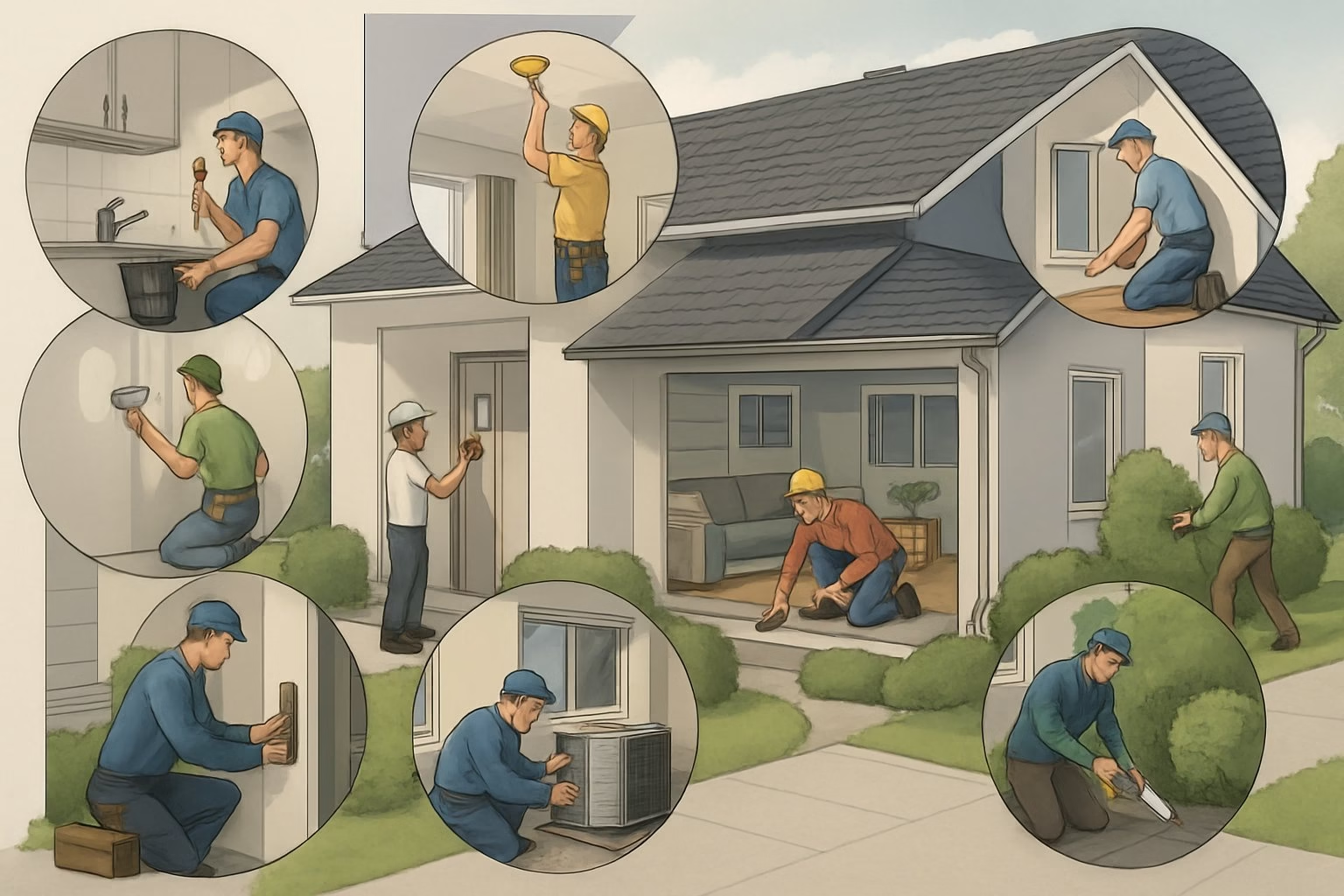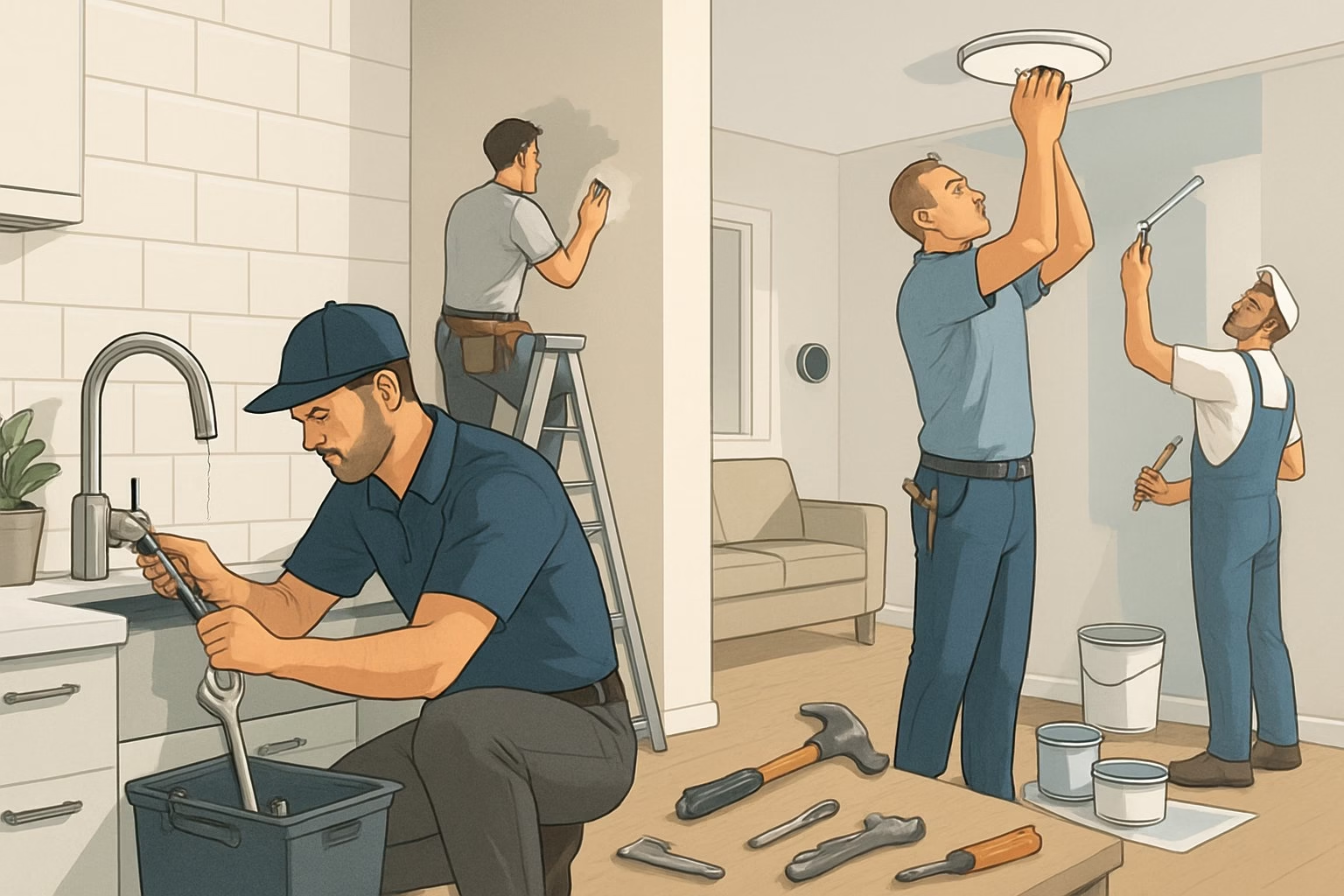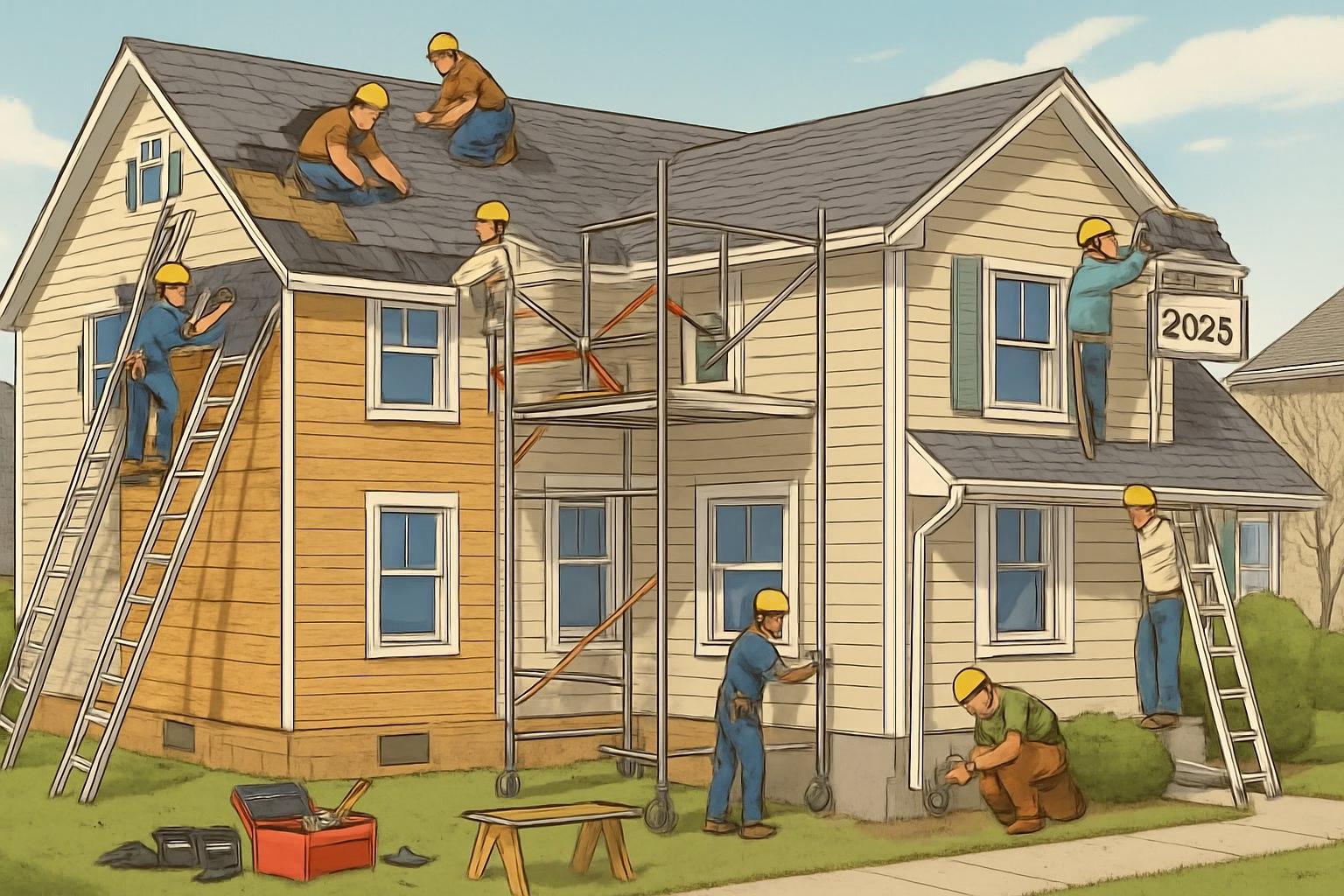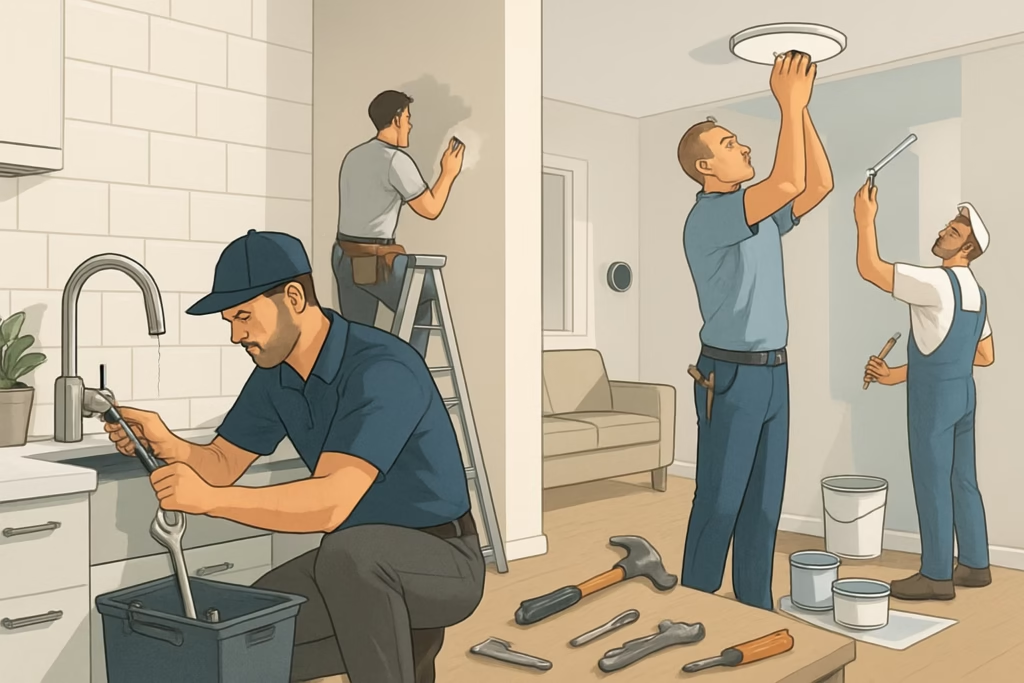Every year, homeowners stare down a longer list of repairs, and yeah, it’s not getting any cheaper. Simple plumbing fixes, big system overhauls—knowing what you’ll likely pay helps you budget and not get blindsided.
Most common home repairs in 2025 land anywhere from $75 for a basic faucet fix to well over $10,000 for big structural stuff. Most repairs fall between $200 and $2,000.

If you keep up with maintenance, you’ll dodge those wallet-busting emergencies. Fixing a leaky faucet for $150 now? That’s way better than dealing with water damage later, which could clean out your savings.
Homeowners who prioritize repairs based on urgency and what could go wrong down the line usually come out ahead. It’s not just about money—it’s about peace of mind.
Roughly 36% of homeowners now focus on regular maintenance instead of waiting for things to break. That’s a smart move, honestly—it saves cash and keeps stress levels in check when surprises pop up.
Key Takeaways
- Most home repairs cost between $75 and $2,000. Simple fixes are way cheaper than big system replacements.
- Staying on top of maintenance helps you avoid those nightmare emergencies that cost a fortune.
- If you plan and budget for repairs, you’ll handle both routine stuff and unexpected breakdowns with less hassle.
Home Maintenance Overview in 2025
In 2025, home maintenance costs are hitting new highs. Annual expenses now run between $4,000 and $22,000 for most homeowners.
Why? Material prices keep climbing, labor’s in short supply, and homes aren’t getting any younger.
Key Factors Impacting Repair Costs
Material costs are up 5% to 7% this year, which blows past the 2.2% inflation rate. Everything from shingles to plumbing parts is pricier thanks to supply chain hiccups and, honestly, just too much demand.
Labor is another headache. Skilled trades like electricians and HVAC techs are tough to find, so their rates keep going up.
Older homes, especially those built decades ago, need more love. Outdated plumbing, worn roofs, and aging electrical systems just can’t wait forever.
Then there’s the weather. Extreme conditions mean HVAC units work overtime, roofs take a beating, and pipes deal with wild temperature swings.
Average Annual Maintenance Budget
Experts say you should stash away 1% to 3% of your home’s value each year for repairs. So, if your place is worth $400,000, you’re looking at $4,000 to $12,000 set aside annually.
Maintenance costs swing a lot depending on your home’s quirks:
| Factor | Impact on Costs |
|---|---|
| Home age | Older homes need 15-20% more maintenance |
| Square footage | Larger homes require proportionally higher budgets |
| Home condition | Well-maintained homes cost 25% less annually |
Regular tune-ups—like HVAC checks, roof inspections, and plumbing once-overs—can stop small problems from snowballing.
Labor Rates and Regional Variations
Labor rates are all over the map in 2025. In cities, you’ll pay 20% to 40% more than in rural spots, mostly because of higher wages and demand.
Regional cost variations include:
- Northeast: Rates are 30% above the national average
- West Coast: 25% above average, thanks to high living costs
- Midwest: Around the national average
- Southeast: 10-15% below average
Specialized trades charge top dollar. Electricians ask for $75 to $150 an hour, while a handyman typically runs $50 to $80 an hour, depending on where you live.
Remodeling costs jump around by region and project size. Sure, you can estimate materials by square footage, but local labor rates decide the final bill.
Interior Repairs and Upgrades

Interior repairs and upgrades can really change how your home feels and works. Painting a few rooms might cost $1,500-$4,000, while a light kitchen remodel averages $27,500. Bathrooms? Figure on $6,000-$15,000, depending on how far you go.
Interior Painting Costs
Painting is still one of the cheapest ways to give your place a facelift. Most folks spend between $1,500 and $4,000 to paint their home’s interior.
Cost Breakdown by Room:
- Living room: $600-$1,200
- Bedroom: $300-$750
- Kitchen: $500-$1,000
- Bathroom: $200-$500
Paint quality matters—a lot. The fancy stuff is $50-$80 a gallon, but it lasts way longer than the bargain brands at $25-$35.
Labor eats up 70-80% of your painting budget. Most pros charge $3-$6 per square foot for walls and ceilings.
If you need holes patched, surfaces sanded, or primer slapped on, expect your total to climb by 20-30%.
Minor Kitchen Remodel Expenses
A minor kitchen remodel sets you back around $27,500. These projects stick to cosmetic upgrades, not gut jobs, and the payoff can be pretty solid.
Common Minor Remodel Elements:
- Cabinet refacing: $4,000-$9,000
- Countertop replacement: $1,500-$4,500
- New appliances: $3,000-$8,000
- Updated lighting fixtures: $500-$2,000
- Flooring replacement: $2,000-$5,000
Cabinet updates really change the look. If you keep your cabinet boxes and just swap out the doors and drawers, you’ll save a chunk of change.
When it comes to appliances, going for energy-efficient models makes sense. They cut down your utility bills and just work better.
Lighting is underrated—LED strips under cabinets or pendants over the island make a huge difference.
Bathroom Remodel Pricing
Bathroom remodels usually run from $6,000 for the basics to $15,000 for something more mid-range. Final cost depends on what you pick for fixtures and how much you do.
Budget Breakdown:
- Vanity and sink: $800-$2,500
- Toilet replacement: $300-$800
- Shower/tub fixtures: $1,200-$4,000
- Flooring: $500-$2,000
- Tile work: $1,500-$4,500
Upgrading fixtures gives you an instant lift. New faucets, showerheads, and lights can make an old bathroom feel fresh without tearing down walls.
Switching out tile has a big visual impact. Subway and large tiles are still crowd-pleasers, for whatever that’s worth.
Swapping the vanity updates storage and style. Floating vanities look modern, while old-school styles fit traditional homes better.
Major Exterior Repairs and Renovations

Exterior repairs keep your home safe from the elements and help it hold value. Roofs usually cost $7,000 to $25,000, windows go from $300 to $800 each, and painting the outside averages $3,000 to $6,000.
Roof Replacement and Repair Costs
Most roofs last about 25 years before you have to bite the bullet and replace them. Roof replacement cost depends on what you use and how big your house is.
Asphalt shingles run $5,000 to $12,000 for most homes. Metal roofs? Think $10,000 to $20,000. If you want clay tiles, you’re looking at $15,000 to $25,000.
Major repairs, like swapping out underlayment or flashing, cost $2,500 to $5,000. If a storm knocks off shingles or causes a small leak, you’ll pay $300 to $800 for a quick fix.
Roof material choices affect both cost and lifespan:
- Asphalt: 20-25 years
- Metal: 40-70 years
- Clay tiles: 50-100 years
Storm damage repairs usually cost $1,500 to $4,000. It’s never fun, but it happens.
Window Replacement Averages
Swapping out windows boosts energy efficiency and curb appeal. Standard double-hung windows installed cost $300 to $600 each.
Window replacement cost varies by type:
| Window Type | Cost Range |
|---|---|
| Single-hung | $200-$500 |
| Double-hung | $300-$600 |
| Casement | $400-$700 |
| Bay/Bow | $1,000-$3,000 |
Full-frame replacements cost more than inserts. Vinyl windows are cheaper than wood or fiberglass, but maybe not as charming.
Energy-efficient windows with Low-E coatings tack on $50 to $100 per window. Labor for installation typically runs $100 to $200 per window.
Most homes need 10 to 20 windows replaced, so total project costs land between $3,000 and $12,000 for an average place.
Exterior House Painting Costs
Exterior house painting cost depends on your home’s size and paint quality. Most folks spend $3,000 to $6,000 for a pro job.
Paint itself is $30 to $60 a gallon. The good stuff costs more but lasts longer. Labor makes up about 70% of what you’ll pay.
Other cost factors:
- Square footage: $1.50 to $3.00 per square foot
- Number of stories: Two-story homes cost 20% more
- Surface prep: Scraping and priming add $500 to $1,500
Small homes (1,200 sq ft) cost $2,500 to $4,000. If you have a larger place (3,000 sq ft), expect $5,000 to $9,000.
Painting trim adds $1 to $3 per linear foot. Power washing before painting bumps the price by $200 to $500.
Quality paint jobs last 7 to 10 years, but if you go cheap, you’ll probably repaint in 3 to 5 years.
Essential System Replacements
When a system finally gives out, replacement beats endless repairs. HVAC swaps are among the priciest jobs, but going energy-efficient can save money over time—even if it stings up front.
HVAC System Replacement Costs
Complete HVAC system replacement usually costs between $5,000 and $12,000 for most homes.
The price depends on system size, efficiency, and how tricky the installation gets.
Central Air Conditioning Units run $3,000 to $7,000 installed.
If you want a high-efficiency model with a SEER above 16, expect to pay more upfront, but you’ll probably notice your energy bills drop after that.
Furnace replacement costs fall between $2,500 and $6,000, depending on fuel type.
Gas furnaces usually cost less than electric or oil, and modern units can last 15 to 20 years if you keep up with maintenance.
Heat pump systems cost $4,000 to $8,000 installed.
Since they heat and cool, they’re a solid choice for moderate climates.
Labor makes up about 30% to 40% of the total bill.
If you need ductwork changes or electrical upgrades, that can tack on another $1,000 to $3,000.
Energy-Efficient Upgrades
Energy-efficient upgrades cost 15% to 30% more than standard models, but you’ll save on utilities over time.
Smart thermostats cost $200 to $500 installed.
They can cut heating and cooling costs by 10% to 15% by learning your habits and tweaking the temperature automatically.
High-efficiency water heaters range from $1,200 to $3,500.
Tankless models save space and give you endless hot water, but sometimes you’ll need a bigger gas line or electrical work.
Insulation improvements cost $1.50 to $3.50 per square foot.
Good insulation lowers the load on your system and helps it last longer.
Many utility companies offer rebates for energy-efficient replacements.
Federal tax credits up to $2,000 are available for qualifying HVAC systems through 2032.
Outdoor Maintenance and Landscaping
Outdoor maintenance covers regular landscaping, which costs $100 to $200 monthly, and gutter cleaning, usually $100 to $250 a year.
These jobs protect your home’s exterior and help keep property values up.
Landscaping Service Fees
Professional landscaping runs $100 to $200 a month for typical yards, but large properties can hit $300 monthly.
Basic lawn care covers weekly mowing, fertilizing, and weed control.
Most services charge $30 to $85 each mowing visit.
Core landscaping services include:
- Lawn mowing and edging
- Fertilizer applications ($65 to $100 each)
- Weed control treatments ($50 to $125 per application)
- Seasonal yard cleanups
Specialized tasks cost extra.
Tree trimming ranges from $200 to $900 per tree, while leaf removal costs $150 to $350 depending on yard size.
Lawn aeration and dethatching each run $100 to $300.
These services boost soil health and help your grass grow thicker.
Some homeowners save by hiring for just spring or fall cleanups instead of year-round contracts.
Gutter Cleaning and Upkeep
Gutter cleaning costs $100 to $250 on average.
Most homes need it twice a year—spring and fall.
Clogged gutters can damage landscaping and foundations.
In cold climates, they also cause ice dams.
Pros remove leaves and debris, plus check for damage.
They’ll also inspect downspouts and drainage.
Factors affecting gutter cleaning costs:
- House height and roof complexity
- Amount of debris buildup
- Gutter length and accessibility
- Regional labor rates
Homes with lots of trees need more frequent cleaning.
Some folks pay for quarterly service to avoid big clogs.
Gutter repairs add $50 to $200 to the bill.
Common fixes include resealing joints and replacing damaged sections.
Estimating and Managing Home Repair Budgets
To get accurate estimates, compare several contractor quotes and check current labor rates.
It’s wise to budget about 1% of your home’s value each year for repairs, and set aside extra for emergencies.
Evaluating Remodeling Quotes
Always get at least three quotes from licensed contractors for any big repair.
Each quote should break down materials, labor, and timeline.
Quote comparison checklist:
- Materials listed by brand and quality
- Labor hours and rates
- Permit fees
- Cleanup and disposal charges
Labor rates vary a lot by region and specialty.
Electricians often charge $50-100 per hour, plumbers $45-90 per hour in most places.
Contractors may quote fixtures at different quality levels, so ask for specific brands and models to compare apples to apples.
Some quotes include basic fixtures, others go for premium options.
Check contractor licenses and insurance before accepting any quote.
The lowest bid isn’t always the best if materials or workers are subpar.
Planning for Future Repairs
It’s smart to budget 0.5% to 1% of your home’s value each year for maintenance and repairs.
For a $300,000 home, that’s about $1,500 to $3,000 annually.
Create a repair timeline:
- 5 years: Paint touch-ups, HVAC filter changes
- 10 years: Roof inspections, appliance replacements
- 15 years: Flooring updates, exterior painting
- 20 years: Major system overhauls
Emergency repairs average $2,321 a year, so keep that amount in a separate savings account for surprises like burst pipes or electrical failures.
Track your home’s repair history—it helps predict future needs.
Older homes usually need bigger repair budgets than newer ones.
Frequently Asked Questions
Home repair costs swing a lot based on location, materials, and how complicated the job is.
Most homeowners spend $4,000 to $22,000 a year on maintenance, but big repairs like foundation work can hit $10,000 to $40,000.
How are typical home repair costs calculated in 2025?
Contractors figure home repair costs using a few main factors.
Labor usually makes up 40-60% of the total.
Materials cover the rest, and prices change based on quality and what’s available.
Location matters—a lot.
Cities see prices 20-30% higher than rural areas.
The size and severity of the repair also bump up the cost.
Contractors look at the home’s age and condition before quoting.
Older houses often need more work, which means higher costs.
Emergency repairs can cost 15-25% more than planned maintenance.
What are the top 5 most expensive home repairs in 2025?
Foundation repairs top the list at $10,000 to $40,000 for big structural work.
These tackle cracks, settling, and water damage that threaten your home’s stability.
Full roof replacement costs $5,000 to $12,000, depending on materials and size.
That includes tearing off old shingles and putting on a new roof.
HVAC system replacement runs $5,000 to $10,000, covering new heating and cooling units plus labor.
Siding replacement costs $10,000 to $20,000 for a full exterior redo, with prices changing by material.
Deck rebuilding goes from $5,000 to $15,000 for a full replacement, including demo and new construction.
How much should I budget for home maintenance for a 2000 sq ft house in 2025?
A 2000 square foot house usually needs $4,000 to $8,000 a year for maintenance.
This covers routine stuff like HVAC service, gutter cleaning, and minor repairs.
The 1% rule says to budget 1% of your home’s value yearly.
If your place is worth $300,000, that’s $3,000 a year for upkeep.
Newer homes under 10 years old might only need $2,000 to $4,000 per year.
Homes over 20 years old often require $6,000 to $12,000 annually as things start to wear out.
Emergency repairs can add $1,000 to $5,000 on top.
It’s smart to set aside extra for surprise problems like water heater failures or roof leaks.
Are there any online calculators that provide free estimates for home improvement costs?
Yeah, several sites offer free home repair cost calculators.
HomeAdvisor gives estimates based on project and zip code.
Angi has similar tools with local contractor pricing.
Lowe’s and Home Depot offer calculators for materials and installation—handy for flooring, roofing, and kitchen remodels.
RemodelingCalculator.org breaks down costs for lots of improvements, with regional adjustments and material options.
These calculators just give rough estimates, though.
Actual costs can vary by 20-40% depending on your situation.
If you want real numbers, get a professional quote.
What factors influence the rise or reduction of renovation costs in 2025?
Material costs keep shifting thanks to supply chain issues and demand.
Lumber prices are still 15-20% higher than before 2020.
Steel and copper have jumped too.
Labor shortages push contractor rates higher in most places.
Skilled tradespeople can ask for higher wages because there aren’t enough of them.
Energy prices impact shipping and manufacturing costs for materials.
Higher fuel costs mean bigger delivery fees and pricier materials.
Local building codes and permits can add $500 to $2,000 to your project.
Some places make the process easier, which helps cut admin costs.
Seasonal demand matters too.
Spring and summer projects usually cost 10-15% more than winter work—go figure.
What are some common unexpected home repair costs homeowners should be aware of?
Water damage is sneaky and tends to hide bigger headaches. Fixing a small $500 leak sometimes spirals into a $3,000 job once you pull back the wall and spot mold or structural issues.
Electrical work? It’s rarely as simple as swapping out an outlet. You might find out you need to install GFCI protection or even upgrade your electrical panel, which can easily jump the price to $1,000 or more.
Permits and inspections are another curveball. You might think a repair is straightforward, but cities often require permits that tack on $200 to $1,500, and honestly, who budgets for that?
If you run into asbestos or lead paint, brace yourself. Only certified crews can handle removal, and that can add anywhere from $1,000 up to $10,000, all depending on how much they find.
Sometimes, the real trouble doesn’t show up until you start tearing things apart. Hidden structural problems—like a cracked foundation or busted framing—can add $5,000, $10,000, or even more to your costs.

